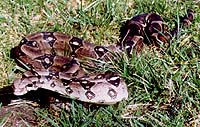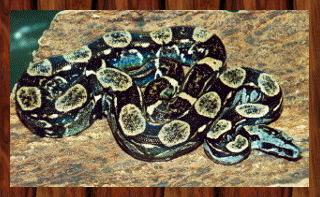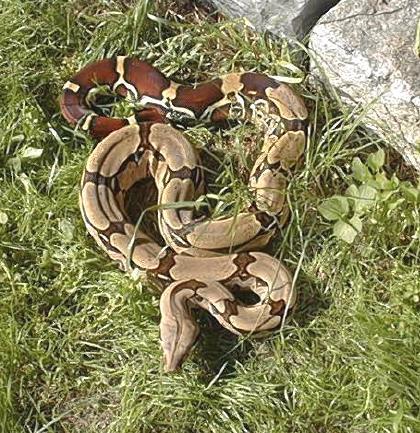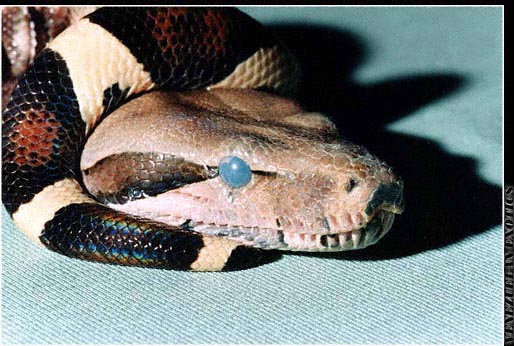Home
Animals
Reptiles
Boa
 Boa
is the common name for about 50 species of snakes closely related to
pythons. The family includes the largest of all snakes, the
water-dwelling anaconda of South America. All boas are nonpoisonous
and kill by constriction. Unlike the pythons, they bear live young.
Boa
is the common name for about 50 species of snakes closely related to
pythons. The family includes the largest of all snakes, the
water-dwelling anaconda of South America. All boas are nonpoisonous
and kill by constriction. Unlike the pythons, they bear live young.
Snakes can detect heat, or infrared, rays through specialized groups
of nerve endings scattered through the skin. Most boas are active at
night and have pits along their lips that are also sensitive to the
heat of prey. Boas are usually handsomely marked and often
iridescent, the most striking being the rainbow boa.
The species best known as "boa" is the boa
constrictor, which ranges from Mexico to Argentina and the West
Indies. These snakes grow up to 12 feet long, but an 18.5-foot
specimen is on record. In the pet trade this snake is often called a
"red-tail" boa because of its reddish brown markings on its tail.
Boas are primitive snakes with anatomical features that reflect their
lizard ancestry, such as bony vestiges of hind limbs that terminate
in external claws, and the presence of two functional lungs instead
of the one found in most snakes.
HABITAT
Red-tail boas blend in very easily with fallen leaves on the ground.
Although they can easily climb trees in the under story and canopy of
the rainforests, and do so to search for food; but they return to the
forest floor to rest where they're very well camouflaged.
Snakes in general, lack external ear openings, eardrums, and
middle-ear cavities. The small sound-conducting bone is still
present. In other reptiles this bone is positioned between the inner
ear and the eardrum, but in snakes it is situated between the inner
ear and the jaw hinge. When the snake's head is on the ground,
vibrations are picked up by the lower jaw and skull and are
transmitted by bone conduction to the inner ear. Snakes, therefore,
can readily detect earth borne sounds. The lack of eardrums and
middle-ear cavities implies that snakes cannot hear airborne sounds.
Certain experiments, however, have shown that the snake's inner ear
does respond to low-frequency airborne vibrations.
The snake's skin is primarily a protective structure, guarding it
against physical injury and the loss of body moisture. The scales
covering the skin are mainly derived from a folding of the upper
layer of the skin. Because the scales do not increase in size or
because the outer layer becomes worn, or because of reasons not yet
understood, a snake must periodically shed its old skin and replace
it with a new and larger one. In molting, the old, upper layer of
skin becomes loose and separated from a newer layer developing
beneath it. The snake loosens the skin around its lips pushing it
back, and crawls out of the old skin turning it inside out. Frequency
of shedding varies according to the growth rate of the snake.
 DIET
DIET
Some snakes simply suffocate their captured prey by squeezing them
with their jaws, but a snake's long, muscular body is ideally suited
for applying pressure on a prey animal. Constriction does not crush
the prey animal but rather prevents it from breathing and suffocates it.
As an adaptation to allow the swallowing of large animals whole, the
snake's skull is very flexible. Elastic ligaments are all that unite
the two halves of the lower jaw permiting them to move apart. A snake
can separate its upper and lower jaws and also the two halves of its
bottom jaw to swallow prey more than three times larger than its self.
GESTATION
In the wild, boas reach sexual maturity at two or three years and
breed during the rainy season. If fed appropriately, most
captive-raised boas will become sexually mature by the end of their
third year. Once conception has occurred, boas usually remain
pregnant for 4 to 10 months and then give birth to live young called
neonates. They hold approximately 20 to 60 eggs internally until they
hatch and then the hatchlings and the leathery shells are expelled
from the mother snake. Neonates weigh approximately two to three
ounces, are between 14 to 22 inches in length, and will eat soon
after their first shed--about one week after birth.
 LONGEVITY
LONGEVITY
Boas are among the longest lived of all snake species. Reports of
boas living up to 20 years are common. One specimen at the
Philadelphia Zoological Gardens lived for 40 years, 3 months and 14 days.
BIBLIOGRAPHY
Grolier's Encyclopedia Vosjoli, Philippe de. The General Care and
Maintenance of Red-Tailed Boas Wildlife Fact File
 Boa
is the common name for about 50 species of snakes closely related to
pythons. The family includes the largest of all snakes, the
water-dwelling anaconda of South America. All boas are nonpoisonous
and kill by constriction. Unlike the pythons, they bear live young.
Boa
is the common name for about 50 species of snakes closely related to
pythons. The family includes the largest of all snakes, the
water-dwelling anaconda of South America. All boas are nonpoisonous
and kill by constriction. Unlike the pythons, they bear live young.
 DIET
DIET
 LONGEVITY
LONGEVITY